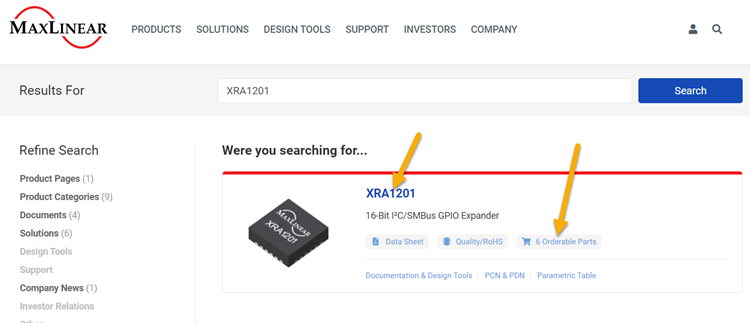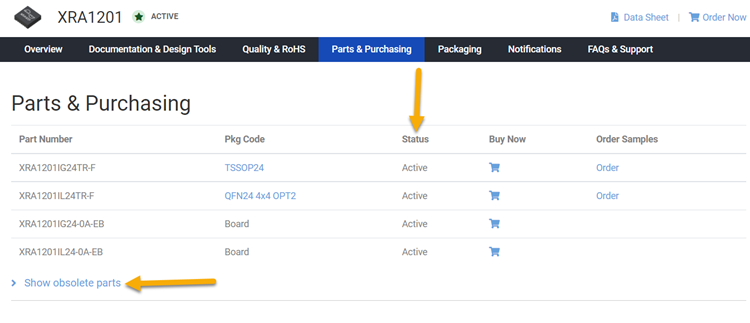
XR33180
Overview
| Information | |
|---|---|
| Supported Protocols | RS-422, RS-485 |
| Supply Voltage (Nom) (V) | 3.3, 5 |
| No. of Tx | 0 |
| No. of Rx | 1 |
| Duplex | |
| Data Rate (MAX) (Mbps) | 52 |
| HBM ESD (kV) | 15 |
| IEC 61000-4-2 Contact (±kV) | 8 |
| Rx Fail-Safe | Advanced |
| Multi-Drop Nodes | 128 |
| Transient Tolerance (V) | |
| Fault Tolerance (V) | |
| VL Pin | |
| Temperature Range (°C) | -40 to 125 |
| Package | TSOT23-5 |
| ICC (Max) (mA) | 5 |
| Shutdown | |
| Typ Shutdown Current (µA) | |
| Hot Swap | |
| PROFIBUS (5V) or High Output (3V) |
The XR33180, XR33181, XR33183 and XR33184 are high performance RS-485/RS-422 receivers designed to meet the increasing system requirements found in today’s high performance serial communication applications.
The receiver includes enhanced failsafe circuitry, guaranteeing a logic-high receiver output when the receiver inputs are open, shorted, or undriven. The XR33180/81/83/84 (XR3318x) receiver input impedance is at least 48kΩ (1/4 unit load), allowing more than 128 devices on the bus. The bus pins are ESD protected and pass IEC61000 level 4 (±15kV).
This is a wide supply (3.0V to 5.5V) device that operates at a maximum data rate of 52Mbps and comes in very small 5-pin and 6-pin TSOT23 packages, making this standalone receiver ideal for high speed point-to-point RS-485 applications where space is a concern.
The XR3318x offers several pinout options to maximize performance in different applications while maintaining a minimum pin count. The XR33180 is available in a 5-pin TSOT23 package with the receiver always enabled. The XR33181 is available in a 6-pin TSOT23 package and offers an active high receiver enable pin while the XR33183 has the same pinout but with active low enable pin. The XR33184 is available in a 6-pin TSOT23 package with an I/O logic supply pin to ease the interface to MCU’s or FPGA’s that run off of different supply voltages. The VL supply pin allows the XR33184 to interface to other devices running off of supplies from ranging from 1.65V to VCC.
All XR3318x options operate up to a max data rate of 52Mbps and have excellent propagation delay and skew characteristics making them a good choice for clock fanout or clock distribution systems.
- Wide 3V to 5.5V supply operation
- 52Mbps data rate
- Robust ESD protection
- ±15kV human body model
- ±15kV IEC61000-4-2 air discharge
- ±8kV IEC61000-4-2 contact discharge
- Enhanced receiver failsafe protection for open, shorted, or terminated but idle data lines
- 1.65 to 5.5V Logic Interface VL pin (XR33184)
- Enable (high and low) pins for redundant operation
- Three-state output stage (XR33181, XR33183)
- 15ns maximum receiver propagation delay
- 2ns maximum receiver skew
- 8ns maximum package-to-package skew time
- -7V to +12V common mode range
- Reduced unit loads allows up to 128 receivers on bus
- Tiny TSOT23-5 package
- -40°C to 125°C ambient operating temperature range
- Base stations
- Clock distribution
- HVAC networks
- Building and process automation
- Security equipment
- Telecom equipment
- Local area networks
- Industrial process control
- Point-of-sale equipment
Documentation & Design Tools
| Type | Title | Version | Date | File Size |
|---|---|---|---|---|
| Data Sheets | XR33180/81/83/84 3V to 5.5V, 52Mbps, TSOT23 RS-485/RS-422 Receivers with ±15kV ESD Protection | 1D | May 2022 | 616.3 KB |
| Application Notes | AN-291, RS-485 Advanced Fail-Safe Feature | R01 | May 2023 | 3.7 MB |
| Application Notes | RS-232 and RS-485 PCB Layout Application Note | R00 | December 2022 | 2.8 MB |
| Application Notes | AN-292, RS-485 Cable Lengths vs Data Signaling Rate | R01 | July 2022 | 2.7 MB |
| Product Brochures | Interface Brochure | R01 | June 2024 | 3.6 MB |
Quality & RoHS
Parts & Purchasing
| Part Number | Pkg Code | Min Temp | Max Temp | Status | Buy Now | Order Samples |
|---|---|---|---|---|---|---|
| XR33180ESBTR | TSOT5 | -40 | 125 | Active | Order | |
| XR33180ESBEVB | Board | Active |
Active - the part is released for sale, standard product.
EOL (End of Life) - the part is no longer being manufactured, there may or may not be inventory still in stock.
CF (Contact Factory) - the part is still active but customers should check with the factory for availability. Longer lead-times may apply.
PRE (Pre-introduction) - the part has not been introduced or the part number is an early version available for sample only.
OBS (Obsolete) - the part is no longer being manufactured and may not be ordered.
NRND (Not Recommended for New Designs) - the part is not recommended for new designs.
Packaging
| Pkg Code | Details | Quantities | Dimensions |
|---|---|---|---|
| TSOT5 |
|
|
|
Notifications
FAQs & Support
Search our list of FAQs for answers to common technical questions.
For material content, environmental, quality and reliability questions review the Quality tab or visit our Quality page.
For ordering information and general customer service visit our Contact Us page.
Submit a Technical Support Question As a New Question
For RS-232 it is 50 feet (15 meters), or the cable length equal to a capacitance of 2500 pF, at a maximum transmission rate of 19.2kbps. When we reduce the baud rate, it allows for longer cable length. For Example:
| Baud Rate (bps) | Maximum RS-232 Cable Length (ft) |
| 19200 | 50 |
| 9600 | 500 |
| 4800 | 1000 |
| 2400 | 3000 |
Fail Safe is an attempt to keep the output of the RS-485 receiver to a known state. Transceivers may have standard fail safe or advanced / enhanced receiver fail safe features. Standard fail safe supports open inputs while enhanced fail safe transceivers such as the SP339 and XR34350 support open input, shorted input and undriven terminated lines without external biasing. See Application Note ANI-22 for more detail.
Find the product page of the part that you want to get an evaluation board for and click on Parts & Purchasing. Example:
Find the icons under Buy Now or Order Samples:
Click on the Buy Now icon and see who has stock and click on the Buy button:
Alternatively, you can click on the Order Samples
If the icons are missing, then contact Customer Support.

The Parts & Purchasing section of the product page shows the Status of all orderable part numbers for that product. Click Show obsolete parts, to see all EOL or OBS products.

Videos
RS-485 Transceivers - Advance vs. Standard Failsafe
MaxLinear offers RS-485 transceivers with both standard and advanced receiver failsafe features. This video will show the main differences and advantages between advanced failsafe receivers and standard failsafe receivers in a typical RS485 installation.
Tips to Maintain a Successful RS-485 Link
This video provides four tips to help maintain RS-485 serial communication without data loss


